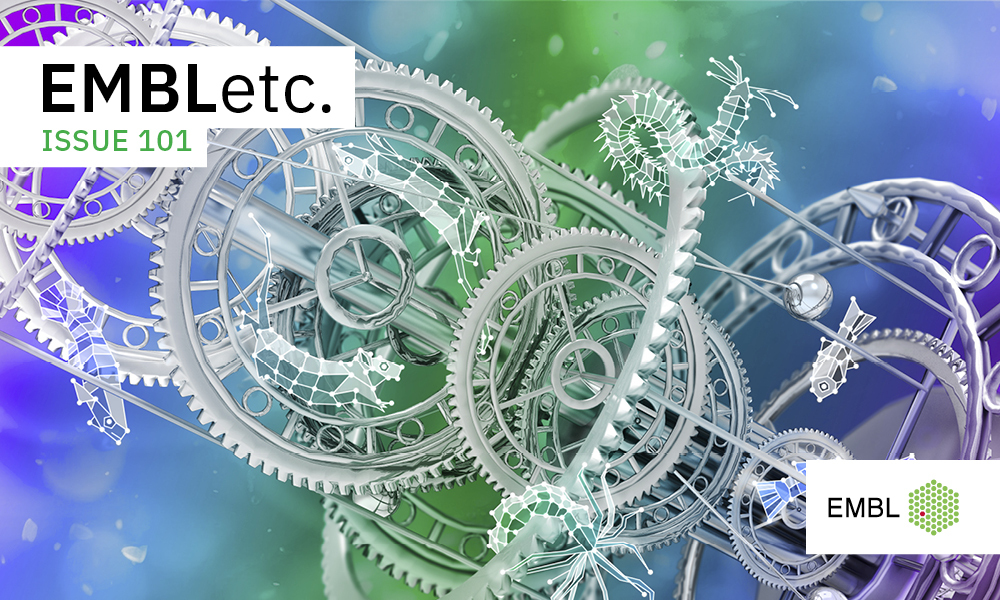
EMBLetc. issue 101 published
The newest issue of our online magazine dives deep into a critical research direction in developmental biology, structures of promiscuous proteins, EMBL’s newest service offerings in field research, and much, much more

In 1974, after years of planning and deliberation, 10 founding member states ratified the agreement to establish EMBL as Europe’s life science laboratory. As we head into our 50th year, we are looking back as well as forward at our traditions of scientific discovery, innovation, and collaboration. At this time of transition, we are excited to bring you another action-packed edition of EMBLetc., the biannual magazine that highlights EMBL’s research, people, and projects.
Here is a sneak peek at stories in this issue that shed light on the range of scientific contributions made by EMBL and its people – past and present.
Why time is of the essence in development
Developmental biologists have long appreciated the critical importance of when things happen, at what pace, and how they correlate with major transitional events of development. Fundamental research conducted by scientists at EMBL Heidelberg is helping provide a clearer understanding of how time, timing, and transitions shape living systems and the varied internal and external cues that provoke changes in form, function, and behaviour.
Embracing the genome sequencing revolution
EMBL’s GeneCore, also known as the Genomics Core Facility, has lived through the revolution in the field of genomics. The facility started out in 2001 as a Sanger sequencing provider. Fast forward 22 years, and it’s now a next-generation sequencing platform that supports researchers across EMBL’s member states with its wide array of advanced genomics services, facilitating groundbreaking research and fostering scientific innovation.
The secret of molecular promiscuity
How do cells eat? While they don’t have mouths, they have a set of transporter molecules specialised in taking up different nutrients, such as sugars, fats, and pieces of digested proteins – called peptides. Peptide transporters are quite unusual because they are highly ‘promiscuous’, which means they transport almost any type of short peptide, regardless of shape and composition. How do they achieve this? The Löw Group at EMBL Hamburg and the Center for Structural Systems Biology (CSSB) is trying to untangle this mystery with cutting-edge structural biology methods.
Deciphering the data deluge: how large language models are transforming scientific data curation
In a world inundated with data, curating valuable information has never been more challenging, or more important. From academic papers to scientific databases, the deluge of new information can be overwhelming, leaving researchers constantly struggling to keep up. However, a groundbreaking innovation in artificial intelligence is helping to transform data curation: large language models (LLMs) such as those behind ChatGPT. Powered by sophisticated deep-learning algorithms, these models are revolutionising how we streamline and curate massive volumes of data.
Taking science on the road
EMBL’s Advanced Mobile Laboratory (AML) brings cutting-edge technology directly to the field, helping researchers carry out advanced sample preparation, metadata acquisition, and analysis – immediately after sample collection. In addition to equipment that helps prepare samples for cryo-electron microscopy – such as a high-pressure freezer and a plunge freezer, the AML also contains advanced technologies for cell sorting, single-cell transcriptomics, and automated confocal microscopy.
Looking back: the moment EMBL was established
The idea for creating a European molecular biology laboratory was first proposed when two Nobel Prize-winning biologists, John Kendrew and James Watson, met with Leo Szilard, a Hungarian-German-American physicist and inventor, and Victor Weisskopf, CERN’s Director General, in Geneva in December 1962. Eleven years later, the EMBL Agreement was signed by its 10 founding member states, to be ratified later in July 1974.
Advocating for a generalist approach to science and life
EMBL alumna Sara Fahs is an Associate Director at BioNTech SE, where for the last several years, she has advanced projects in the area of translational medicinal chemistry. Originally trained as a chemist, Fahs is a strong advocate for a generalist approach to science, where acquiring a range of skills and knowledge enhances one’s creativity as well as problem-solving abilities. In this issue, she writes about key insights from her journey in science, in a career that has spanned academia and industry.
Impact of access to imaging technologies on scientific achievements
Baubak Bajoghli’s interest in microscopy began at age 14, when he visited a medical diagnostics laboratory for a high school project. In a career that spanned both fundamental and translational research, EMBL alumnus Bajoghli has sustained a passion for imaging and recently became Director of Austrian Bioimaging/CMI, where he works to improve researchers’ access to advanced microscopy infrastructure.
Awards and honours
EMBL researchers are often recognised for their work. Here is a list of some of the awards and honours they have received in the past six months.


